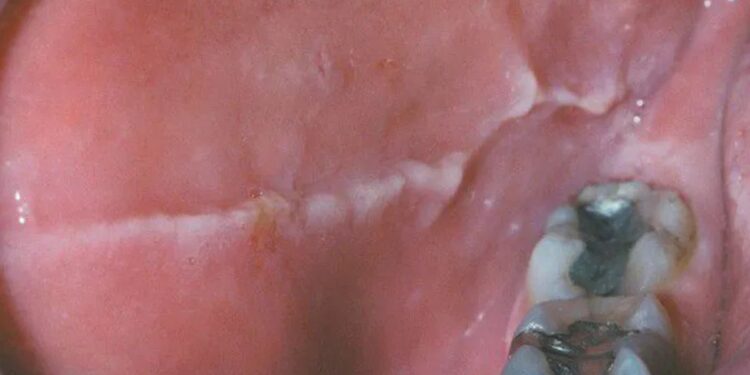Have you ever noticed a faint white line running along the inside of your cheeks? That’s called linea alba, a harmless yet common oral condition. Many people mistake it for an abnormality, but in most cases, it’s just the body’s reaction to pressure and friction inside the mouth. So, is it something to worry about? Let’s dive deep into what causes it, how to identify it, and what you can do about it.
Table of Contents
Understanding Linea Alba
What is Linea Alba?
The linea alba in the mouth appears as a white, slightly raised or flat line along the inner cheek. It is often bilateral (appearing on both sides) and runs parallel to where the upper and lower teeth meet.
Common Locations
- Inner cheeks (most common)
- Lips (less common)
- Along the tongue (rare cases)
It forms due to chronic pressure, friction, or irritation, making it a benign and self-limiting condition in most cases.
Causes of Linea Alba
1. Friction and Pressure
One of the most common causes of linea alba is repeated pressure or irritation against the cheek. This can be due to:
- Habitual Cheek Biting – Some people unconsciously bite their cheeks, creating irritation along the inner surface.
- Bruxism (Teeth Grinding & Clenching) – Constant grinding can cause pressure against the soft tissues of the cheeks, leading to linea alba formation.
2. Irritation from Teeth and Dental Appliances
- Sharp Tooth Edges – Uneven or sharp teeth may constantly rub against the inner cheek, creating the white line.
- Braces, Dentures, and Retainers – These dental appliances can irritate the soft tissues, increasing friction inside the mouth.
3. Oral Hygiene and Lifestyle Factors
- Brushing Too Hard – Excessively forceful brushing can lead to irritation and even damage the soft tissues inside the mouth.
- Smoking and Tobacco Use – Chronic exposure to tobacco products can lead to changes in the oral lining, including the appearance of linea alba.
Symptoms and Diagnosis
How to Recognize Linea Alba
- White or pale line along the inner cheek
- Slightly raised but smooth texture
- Typically painless and symmetrical
How Dentists Diagnose It
- A simple visual examination is usually enough.
- Dentists may check for signs of oral lichen planus, leukoplakia, or other white lesions to rule out serious conditions.
Is Linea Alba Harmful?
In most cases, linea alba is harmless and does not require medical treatment. However, if the lesion:
- Becomes painful
- Grows irregular or thick
- Does not heal or changes color
…then it’s essential to consult a dentist to rule out underlying issues.
Treatment and Management
1. Self-Care and Lifestyle Changes
- Avoid Habitual Cheek Biting – Be conscious of cheek-biting habits and try to reduce stress-related triggers.
- Manage Bruxism – Wearing a nightguard can help if you grind your teeth in your sleep.
- Stay Hydrated – Drinking water helps maintain oral health and reduces friction.
2. Professional Treatments
- Dental Adjustments – If a sharp tooth or dental appliance is irritating the cheek, your dentist may smooth out the issue.
- Oral Hygiene Improvements – Using a soft-bristled toothbrush and being gentle while brushing can prevent further irritation.
Preventive Measures
Good Oral Habits
- Practice proper brushing techniques
- Avoid biting on the inside of your cheek
- Limit tobacco and alcohol consumption
Regular Dental Checkups
- Visiting your dentist twice a year helps catch any early changes in your oral health.
Conclusion
Linea alba in the mouth is a common, harmless condition caused by friction, pressure, or irritation inside the cheek. While it typically doesn’t require treatment, being mindful of your oral habits can help prevent its occurrence. If you notice any unusual changes, a quick dental checkup can provide peace of mind.
FAQs
1. Can linea alba go away on its own?
Yes, in most cases, it fades on its own once the source of irritation is removed.
2. How do I know if my linea alba is serious?
If it becomes painful, irregular, or doesn’t heal, it’s best to see a dentist.
3. Can smoking cause linea alba?
Yes, tobacco use can irritate the oral tissues, potentially contributing to the condition.
4. Is linea alba linked to oral cancer?
No, linea alba is not cancerous. However, if you notice persistent white patches, consult a dentist.
5. What home remedies help reduce linea alba?
Practicing good oral hygiene, avoiding cheek biting, and staying hydrated can help.


 Home
Home










